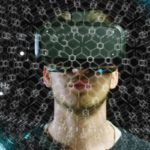Virtual reality, or how science-fiction dreams are coming true
Major companies are now genuinely committing to this technology and have already set out to bring about what was –until a short while ago– no more than science fiction.

February 2015. An Australian, Jason Larke, experiences the birth of his son “live”. He is 4,000 kilometers away from his baby. In Chinchilla, a small town in Queensland –and wearing Samsung's Gear VR glasses– the engineer virtually accompanies his wife during childbirth in a hospital room in Perth. A “miracle”according to the American newspaper The Washington Post. For experts this “miracle” is another example of what can be achieved with virtual reality.
The dictionary of the Spanish Royal Academy defines virtual reality as “the representation of scenes or images of objects produced by a computerized system which gives the sensation they really exist”. The founder of Facebook, Mark Zuckerberg, who in March 2014 shelled out 2 billion dollars for the Oculus VR glasses, defined this technology as follows:
The incredible thing about the technology is that you feel like you're actually present in another place with other people.. Imagine enjoying a court side seat at a game, studying in a classroom of students and teachers all over the world or consulting with a doctor face-to-face –just by putting on goggles in your home”
Over half a century separates this description by the multimillionaire Zuckerberg from that of Ivan Sutherland, considered the father of the infograph and forerunner of virtual reality (1938, Hasting- Nebraska):
A display connected to a digital computer gives us a chance to gain familiarity with concepts not realizable in the physical world. It is a looking glass into a mathematical wonderland. The challenge is to make that world look real, act real, sound real, feel real”
This is how Sutherland described it in his article The Ultimate Display in the 1960s. He created the first program of interactive graphics, the first non-procedural programming language and the first software system oriented to objects. In 1965 –together with one of his Harvard students, Robert Sproull– he created the first DMD interactive visualization headsets, the Head Mounted Display, aimed at pilot training.
In the same line, the grandfather of virtual reality, Thomas Furness, in the 1970s developed the first aircraft cabin simulator for pilot training, known as Visually-Coupled Airborne Systems Simulator (VCASS). This is a cabin that provided 3-D information to pilots who could control the device by means of a virtual representation of the earth with a 120° horizontal field of vision.
The advances continue apace and in 1995 Nintendo presented the first virtual reality console called Virtual Boy with 3D graphics. It was a fiasco; the devices weighed far too much and the first 3-D graphics did not succeed in convincing users they were in a parallel reality. Virtual Boy was too big, and viewing it for several minutes produced headaches.
Over 20 years have elapsed before major companies have once again started believing in virtual reality. A study by Superdata estimates that by 2016 over 10 million users will have a virtual reality headset in their homes. The revolution has come thanks to Oculus Rift, Project Morpheus, Samsung Gear VR and HTC Vive. And it looks like it's here to stay.
Software and hardware join forces to provide a technology that offers a 360° angle of vision when you turn your head, and screens that no longer produce a sensation of giddiness and headache when following moving objects. “One day this type of virtual reality will become a part of daily life for millions of people. Virtual reality was once the dream of science fiction; but the internet was also once a dream, and so were computers and smartphones. The future is coming”. These were Zuckerberg's words after purchasing Oculus VR. This future seems to have already arrived.
The different virtual realities
- Desktop virtual reality systems: The user sees the image in the first person. A 2-D or 3-D image is shown on a computer screen instead of projecting to a HMD. The user travels in any direction within the three-dimensional world displayed on a monitor, headsets, glasses or screen (videogames).
- Second person VR: “Seeing is believing”. The user sees him or herself within the actual scene. He is a “visible” component of the virtual world because he sees the projection of his image in a setting or environment. This system involves real-time perception and responses to the actions of humans who are not wearing headsets, gloves, HMDs, glasses or any other type of interface.
- Telepresence: Telepresence systems form the group of virtual reality applications. These are cameras, tactile and feedback devices linked to remotely controlled elements that enable the manipulation of robots or devices located at a distance while they are experienced in a virtual manner (Telemedicine, Telerobotics).
- Virtual Reality Immersion Systems: They submerge the user in the virtual world using CAVE-type visual systems with position and movement sensors. The user in the virtual world responds to head movements similarly to what occurs in the real world. Immersion worlds exist in three dimensions, and the sensation of depth, perspective and dimension is enabled by sending slightly different images to each eye.